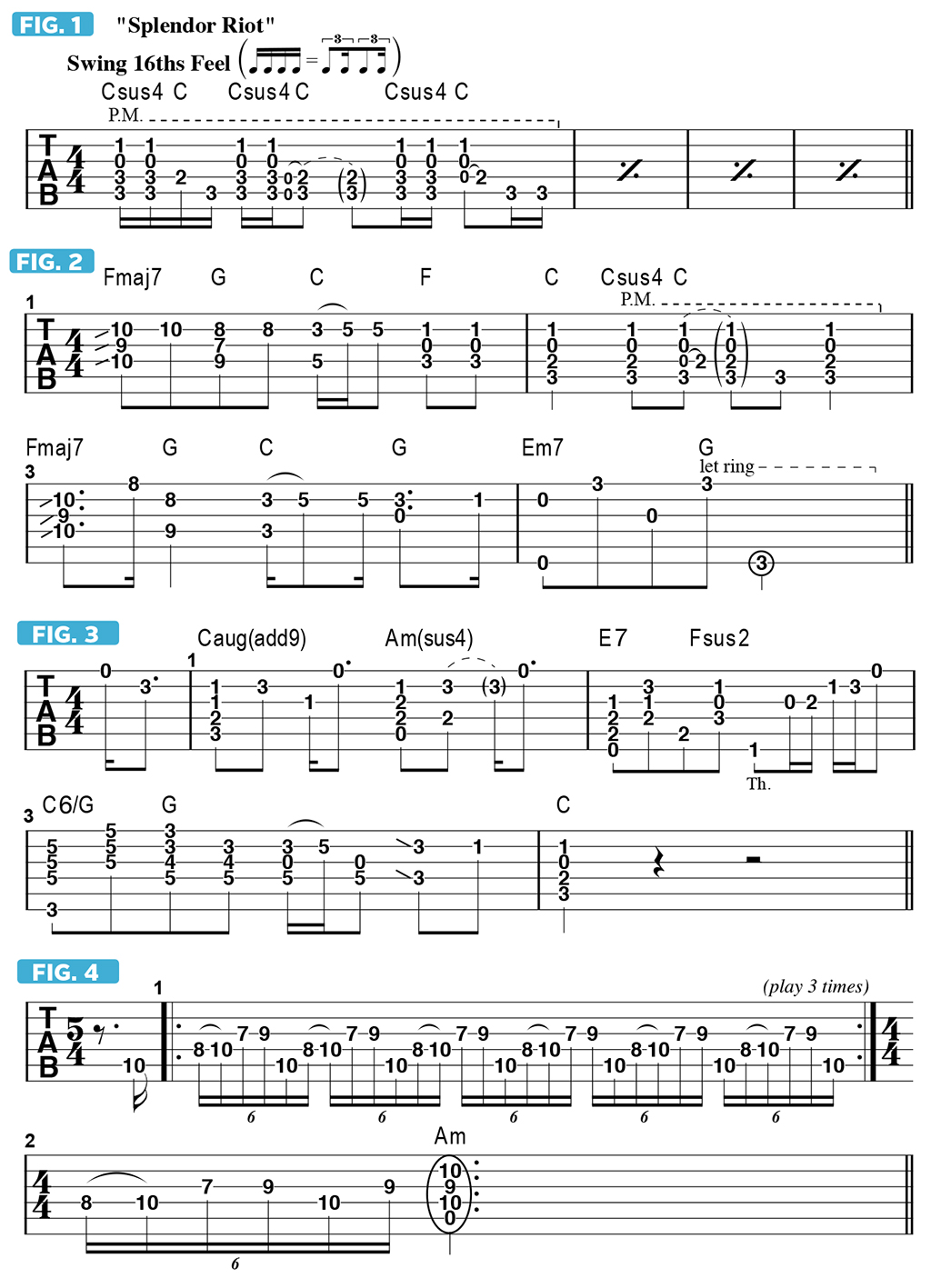All that jazz: how to expand your compositional creativity and play Splendor Riot
Julian Lage teaches you how to think outside the box with your guitar-based compositions
For this column, I’d like to focus on my composition Splendor Riot, from my 2018 release, Modern Lore. As we were preparing to go into the studio to make this record, I looked at Splendor Riot as its centerpiece. In preparing for the recording session, I worked with an incredible songwriter and guitarist, my dear friend Jesse Harris, who produced this album as well as my previous one, 2016’s Arclight. I brought between 30 and 40 songs in for us to consider for Modern Lore, and Splendor Riot earned its place as one of the record’s focal points.
The vibe of this tune can be distilled into its intro rhythm guitar part (FIGURE 1). I alternate between Csus4 and C chords played in first position while palm muting and utilizing hammer-ons when moving from C to Csus4. The rhythmic structure is built around a swing-16ths feel, conveying an undercurrent of 16th-note triplets with even eighth notes. Once we had that groove, we wrote a song around the feeling of that initial figure. I ended up writing about five different versions of this tune - one in which a melody was played over the intro rhythm part, another that moved to a different key, and other variations. The one we chose can be broken down into three complimentary musical events.

The song was envisioned to be performed by a guitar-bass-drums trio, so the initial pattern served to provide a connection point for each instrument, groove-wise. The tune starts, and we all get right on the same page. The next part is one I refer to as the “melody,” though not in a conventional sense; in this instance, the melody resides inside a chordal idea, as shown in FIGURE 2. Utilizing small voicings, I reference the progression Fmaj7 G C F C Csus4 C while providing a simple melodic line on top of it. The second time through, I include G to Em7, with the sequence ending on the V (five) chord, G.
I think of this as the “call” section, often referred to as “A1.” followed by “A2,” which is the “response” to that idea, shown in FIGURE 3. The Caug(add9) chord, which may also be analyzed as E7(b6), resolves to Am(sus4), which then moves to E(7), followed by Fsus2, C/G and G, and in the last bar the progression resolves back to the I (one), C, all the while with a melodic line woven into the changes. I think of this as “part two” of the composition.
After this, we “hang out” for a bit on a vamp, followed by a return to the melody and another vamp, and then we get to “part three,” which is performed in 5/4 meter, as shown in FIGURE 4. Here I play a rapidly ascending line based on C Mixolydian (C D E F G A Bb) that’s a five-note pattern played in a sextuplet rhythm, which results in the “form,” or “shape,” being slightly different on each beat. The figure ends with a shift to Am and a return to the earlier melodic content.
As is my goal with all of my compositions, Splendor Riot is distinct in the manner by which the musical material is put together, while also affording a trio an interesting form to play creatively around and within.
Get The Pick Newsletter
All the latest guitar news, interviews, lessons, reviews, deals and more, direct to your inbox!
“There are so many sounds to be discovered when you get away from using a pick”: Jared James Nichols shows you how to add “snap, crackle and pop” to your playing with banjo rolls and string snaps
Don't let chord inversions bamboozle you. It's simply the case of shuffling the notes around







![Joe Bonamassa [left] wears a deep blue suit and polka-dotted shirt and plays his green refin Strat; the late Irish blues legend Rory Gallagher [right] screams and inflicts some punishment on his heavily worn number one Stratocaster.](https://cdn.mos.cms.futurecdn.net/cw28h7UBcTVfTLs7p7eiLe.jpg)


